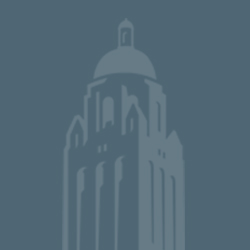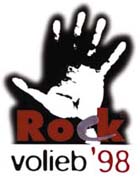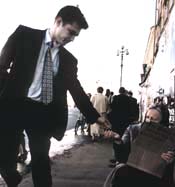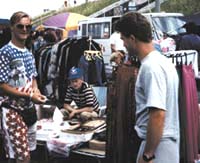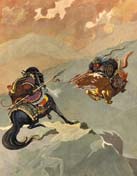|
Cissie Dore Hill
TEN YEARS OF FREEDOM
A Photo Essay on Life after Communism
"If I think about the advantages of Western democracy, I come up with one word—hope. Communism was about life without hope."
—Martin Mejstrik, Czech student leader
The Cold War ended in 1989. The authority of the communist state, along with its obsolete industrial processes and degraded environment, had long since replaced the dream of the workers’ paradise. With tanks or with handshakes, at round tables or in the streets, a system in place for decades began to crumble. In some countries it took only the slightest breath of freedom to bring down the walls.
In 1989 Hungary es-tablished a multiparty system; in Poland roundtable negotiations re-legalized Solidarity and semifree elections were held; East German president Erich Honecker resigned, followed by the fall of the Berlin Wall; a velvet revolution placed Václav Havel in the Czechoslovakian president’s chair; and on December 25 a firing squad executed Romania’s notorious dictator Nicolae Ceausescu and his wife, Elena.
By 1991 the Soviet republics had begun to assert their sovereignty. In a March referendum, 75 percent of voters approved Soviet president Gorbachev’s concept of a renewed federation, but it was too late. Georgia boycotted the vote and in April became the first republic to secede. Following the August coup in Moscow, one republic after another declared independence. Gorbachev’s letter of resignation in December became a mere formality; the Soviet Union was already history.
The transition to democracy proceeded with great speed. New legislative bodies were established and new constitutions written. Election posters dotted the landscape. Although not all election results entirely pleased Western observers, most elections were free and fair, and democracy thrived.
In Slovakia, a 1998 election campaign aimed at eighteen- to twenty-one-year-old voters incorporated Western rock music and media celebrities to encourage young people to vote. More than 80 percent of young voters turned out, and the antireform government of Vladimir Meciar was defeated.
In contrast, democracy is struggling to take root in Azerbaijan and the former Soviet republics of Central Asia. Politicians from the old order are still in power, their terms of office extended by various means. Opposition leaders have been imprisoned, their parties banned. The Organization for Security and Cooperation in Europe (OSCE) monitors elections in these and many other countries, checking for voter fraud and securing ballot boxes to prevent tampering.
Voters have quickly learned to express their voices through the ballot box. In 1998, Latvians passed a referendum liberalizing their restrictive citizenship laws (before 1998 citizenship was limited to Latvians and their descendants living in the country prior to 1940, the year that Stalin occupied the Baltics).
The poster above, produced by the Latvian Center for Human Rights and Ethnic Studies, asks voters to support a liberalization of the citizenship laws. The children’s labels read stateless, Soviet, occupier, nationalist, extremist, and chauvinist, the labels used in the political debate surrounding citizenship. At the bottom of the poster are the words Think before you cast your ballot. Won’t you give these children the opportunity to become Latvian patriots?
When the Iron Curtain parted, and Eastern Europeans could clearly see the West, they were overwhelmed by the standard of living they observed in capitalist countries. Although in some cases lacking the necessary financial institutions on which to base a market economy, governments, using many different models, began to privatize state-owned sectors. Some countries sold vouchers to their citizens, others sold off interests in key industries to political cronies (the nomenklatura of the old system), and still others maintained state control of key industries. Gone was the security blanket of full employment, as companies tried to meet the challenge of competition in a world economy.
Poland, labeled an economic miracle and "Europe’s tiger economy," was the first country in Central and Eastern Europe to bounce back after independence, with its comprehensive economic program of free prices, convertible currency, and privatization.
Poland, Hungary, and the Czech Republic, along with Estonia and Slovenia, are the success stories of the former communist countries. They have been chosen to begin accession negotiations leading to European Union membership.
In countries such as Russia and several of the former Soviet republics, corruption in government and the absence of the rule of law are major obstacles to the successful transition to a market economy. The resulting limited employment, loss of pensions, and irregular payment of wages, particularly in the state-owned sector, have dramatically affected the quality of life for average citizens.
Symbols of national aspiration, suppressed under the communist yoke, reappeared with independence. In some countries this meant the resurrection of precommunist symbols, flags, songs, political parties, and celebrations. National heroes again took their places in city squares.
In other countries, particularly those situated in regions of southeastern Europe that lie on the crossroads of many historical migrations, age-old ethnic rivalries were released and in some cases became violent. In the name of national independence, ethnic sovereignty, or religious freedom, these rivalries destroyed the lives of many combatants and civilians and left countries devastated and impoverished.
Despite the ethnic wars, a resilience manifests itself in the faces of the refugee children in the photo above. These are the faces of hope.
It may be the children’s children of those heroes of 1989 who will achieve the full benefits of democracy and a free society.
Special to the Hoover Digest. The majority of the photos in this essay are from the collection of the Hoover Institution Archives and were displayed in the recent exhibition "Ten Years of Freedom, 1989–1999: The Collapse of Communism and the Transition to Democracy."
Cissie Dore Hill is the exhibits coordinator of the Hoover Institution Archives.
|

